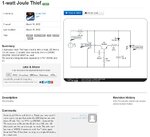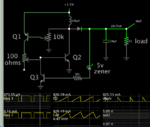neazoi
Advanced Member level 6

Hi I have found and tested this circuit https://simplifier.neocities.org/joule.html The author said that it starts to reduce voltage after 20mA of drawn current or so.
My MCU project requires 75mA and I have to allow for some margin say 100mA.
Note, I have tested the circuit with several common mode chokes (1:1 and a custom wound 3t:3t toroid. The tests have been done with 2n2222 and bd139 transistors only, not the 2n3055 that the circuit shows. For the diode I used a 1n4003 but a schotky diode showed no difference.
and a custom wound 3t:3t toroid. The tests have been done with 2n2222 and bd139 transistors only, not the 2n3055 that the circuit shows. For the diode I used a 1n4003 but a schotky diode showed no difference.
Now, how can I increase the current capability of this circuit so that 5v could be achieved at near 100mA?
I mean what component parameters affect that?
My MCU project requires 75mA and I have to allow for some margin say 100mA.
Note, I have tested the circuit with several common mode chokes (1:1
Now, how can I increase the current capability of this circuit so that 5v could be achieved at near 100mA?
I mean what component parameters affect that?




